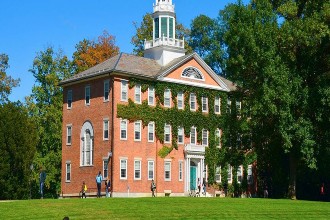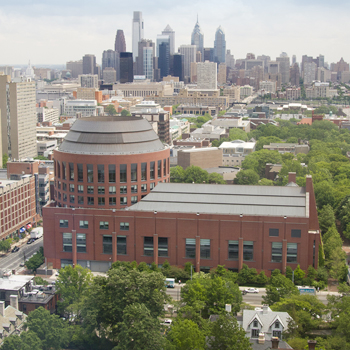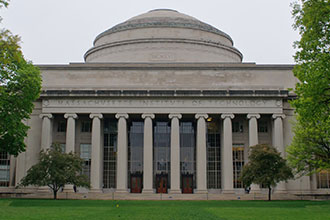REQUIREMENTS AND CAMPUS GUIDE
Massachusetts Institute of Technology
The Massachusetts Institute of Technology was founded in 1865 as a “private university in the public interest”, establishing a tradition of innovative and eventually technology-centric problem-solving for the greater good. MIT is a 166-acre university in Cambridge, Massachusetts and the highest-ranking technical institute in the U.S. Right across the bridge from Boston, and just down the road from Harvard, it’s a home to world-class innovators, engineers, scientists, and maybe even you some day!
The school has an impressive international reputation for STEM, and alumni active across countless scientific and technological industries. Outside of its signature STEM prowess, however, MIT has thriving offerings in Humanities and the arts for students to discover. From big tech to city planning to outer space (the school has 44 alumni astronauts!), MIT-educated changemakers have a reputation of shaping the world around them for the better.
REQUIREMENTS AND CAMPUS GUIDE
Massachusetts Institute of Technology
The Massachusetts Institute of Technology was founded in 1865 as a “private university in the public interest”, establishing a tradition of innovative and eventually technology-centric problem-solving for the greater good. MIT is a 166-acre university in Cambridge, Massachusetts and the highest-ranking technical institute in the U.S. Right across the bridge from Boston, and just down the road from Harvard, it’s a home to world-class innovators, engineers, scientists, and maybe even you some day!
The school has an impressive international reputation for STEM, and alumni active across countless scientific and technological industries. Outside of its signature STEM prowess, however, MIT has thriving offerings in Humanities and the arts for students to discover. From big tech to city planning to outer space (the school has 44 alumni astronauts!), MIT-educated changemakers have a reputation of shaping the world around them for the better.

REQUIREMENTS AND CAMPUS GUIDE
Massachusetts Institute of Technology
The Massachusetts Institute of Technology was founded in 1865 as a “private university in the public interest”, establishing a tradition of innovative and eventually technology-centric problem-solving for the greater good. MIT is a 166-acre university in Cambridge, Massachusetts and the highest-ranking technical institute in the U.S. Right across the bridge from Boston, and just down the road from Harvard, it’s a home to world-class innovators, engineers, scientists, and maybe even you some day!
The school has an impressive international reputation for STEM, and alumni active across countless scientific and technological industries. Outside of its signature STEM prowess, however, MIT has thriving offerings in Humanities and the arts for students to discover. From big tech to city planning to outer space (the school has 44 alumni astronauts!), MIT-educated changemakers have a reputation of shaping the world around them for the better.
School Location:
CAMBRIDGE, MA
School Type:
PRIVATE RESEARCH UNIVERSITY
Admissions Rates:
ADMITTED: 4.8%
GENERAL INFO
SAT/ACT Scores:
Test Optional for 2024-2025
Admission Cycle
Class of 2027 Test Scores
SAT MATH: 780-800
SAT EWR: 740-780
Middle 50% ACT: 34-36
Dates/Deadlines:
Early Decision I (ED I):
November 1
Regular Decision:
January 4
School Information:
Undergraduate population:
4,657
Faculty Ratio:
3:1
Interviews Considered:
Yes
MIT TIPS & GUIDE
How difficult is it to get into MIT?
MIT is a very selective university. Of the 26,914 students who applied to MIT in the 2022-23 cycle, 1,291 were offered admission to the Class of 2027, making the acceptance rate 4.8%. The EA acceptance rate was slightly higher, at 5.7%, as MIT accepted 685 of the 11,924 students who applied for Early Admission. Test scores range near perfection across the board—the 25th and 75th percentiles for the ACT composite were 34 and 36, the SAT Math 780 and 800, and the SAT ERW 740 and 780, respectively.
Although MIT is a STEM-focused school where competitive test scores are a prerequisite for admission, they also care greatly about school fit. They want skilled students who make an impact in an area they are very passionate about, take risks, and work well with others. The most attractive candidates are those who demonstrate initiative and ownership of their own learning and opportunities.
MIT encourages interested applicants to attend an interview in their area or via Skype during the application process. These interviews last anywhere between 30 minutes and two hours. Although an interview is not mandatory and won’t make or break a student’s application, interviews are a helpful tool for showing MIT what makes you a unique and valuable member of their community.
What is the campus like at MIT?
You might imagine a campus full of Nobel Prize-bound scientists to be serious and a bit dull, but MIT is actually the complete opposite. MIT has an open campus, so while you might be in lecture halls with Nobel laureates and MacArthur fellows, when you step outside you’ll be greeted by jugglers and fire spinners alongside the tourists and other students. MIT’s museums and libraries are open to the public, so even those academic spaces are much more diverse than those at a typical college campus.
The campus boasts more than 20 gardens and green spaces to soak up the sun when you’re not braving the legendary New England winters. Cambridge is America’s oldest college town, and Boston is as college-friendly as its neighbor. Throughout the school year, there are events across the city that college students can enjoy, as well as easy transportation to New Haven, Providence, and New York for when you want to break out of the Cambridge bubble.
All MIT freshmen must live in a residence hall, even if they choose to affiliate with an FSILG (Fraternity, Sorority, or Independent Living Groups). The summer before freshman year, students rank the ten residence halls in order of preference. If you end up in a residence hall you don’t love, you can apply to transfer dorms at the beginning of each year. During sophomore–senior year, students have the option to continue living in residential halls or move to an FSILG. More than 3,400 undergraduates live on campus, and nearly half of MIT’s undergraduate students are affiliated with an FSILG, so you won’t be the odd one out if you choose to do so. Keep in mind that each of the residence halls and FSILGs vary in cost and have distinct cultures and rules.
Embracing a work-hard-play-hard attitude, MIT also has a colorful historical tradition of ethical hacks and pranks.
What is MIT known for?
MIT is a world-class institution with particular prestige in science, engineering and mathematics. The U.S. has sent 44 MIT-educated astronauts to space as of 2024, and the institution boasts 101 Nobel Prize winners, 26 Turing Award winners, and 8 Fields Medalists as of October 2023. Notable alumni include astronaut Buzz Aldrin, nuclear physicist Shirley Ann Jackson, and UN Secretary-General Kofi Annan (honorable mention: Marvel Universe character Tony Stark).
How diverse is MIT?
For the Class of 2027, 49% of students identified as male, 48% of students identified as female, 4% identified as another gender identity, and 2% declined to disclose (total exceeds 100%, as students could indicate more than one option). Forty percent are Asian American, 38% are White/Caucasian, 16% are Hispanic, 15% are Black/African American, and 2% are American Indian/Alaskan Native and 1% are Native Hawaiian (likewise, total exceeds 100%, as students could indicate more than one option). The most recent class of 1,092 MIT students hails from 49 states and 59 countries, and 18% were among the first generation in their family to attend college.
How do I apply to MIT?
MIT has both Early Action (EA) and Regular Action (RA) deadlines. Early applicants must submit their materials by November 1. Students applying in the Regular Action cycle need to do so by January 4. It is important for students to note that MIT is not test-optional. In addition to filling out the MIT Application and submitting essays for all MIT supplements, students will have to submit one evaluation from a science or math teacher and one from a humanities, social science, or language teacher. You can also submit additional materials via fax (most ideal) or mail.
Does MIT have a good athletic department?
Boasting an active and distinguished Division III athletics program, MIT supports one of the broadest intercollegiate athletic programs in the world. Approximately 25% of the student body participates in the 33 varsity sports, and at 233 Academic All-America citations, the university has earned more than any other Division III athletics program in the nation.
The MIT Engineers compete at the Division I level in crew, fencing, track and field, cross country, squash, water polo, rifle, and sailing. Outside of the varsity level, MIT also has an expansive club program with 900 participants and 33 teams – a quarter of these reside within martial arts alone!
What are MIT’s core curriculum and programs?
MIT consists of six schools, across which there are 58 majors and 59 minors. The six schools are School of Architecture and Planning, School of Engineering, School of Humanities, Arts, and Social Sciences, MIT Sloan School of Management, School of Science, and the MIT Schwarzman College of Computing. Unlike some other colleges, MIT applicants don’t have to apply to a specific school. All MIT undergrads enter undeclared and choose a school during their sophomore year. In this approach, students have time to explore classes from all six schools and make an informed decision about which major is the best option for them. Some of the most popular areas of study are within Science and Math, but MIT offers everything from Ancient and Medieval Studies to Flexible Nuclear Science and Engineering. Many of the majors are also offered as minors, so if you’re interested in both humanities and STEM, MIT allows you to pursue your passions in a dynamic and intentional way.
Can I afford MIT?
MIT is one of only seven universities in the nation to offer full-need aid and need-blind admissions and one of only five U.S. universities to be need-blind for both domestic and foreign students,. The full price of an MIT education for the 2024–25 academic year (including tuition, fees, room, board, food, books, course materials, supplies, equipment and personal expenses) is $85,960. Families with incomes and assets totaling under $140,000 receive MIT Scholarship funding, allowing them to attend MIT tuition-free, while families making under $75,000 are exempt from any expenses towards an MIT education.




